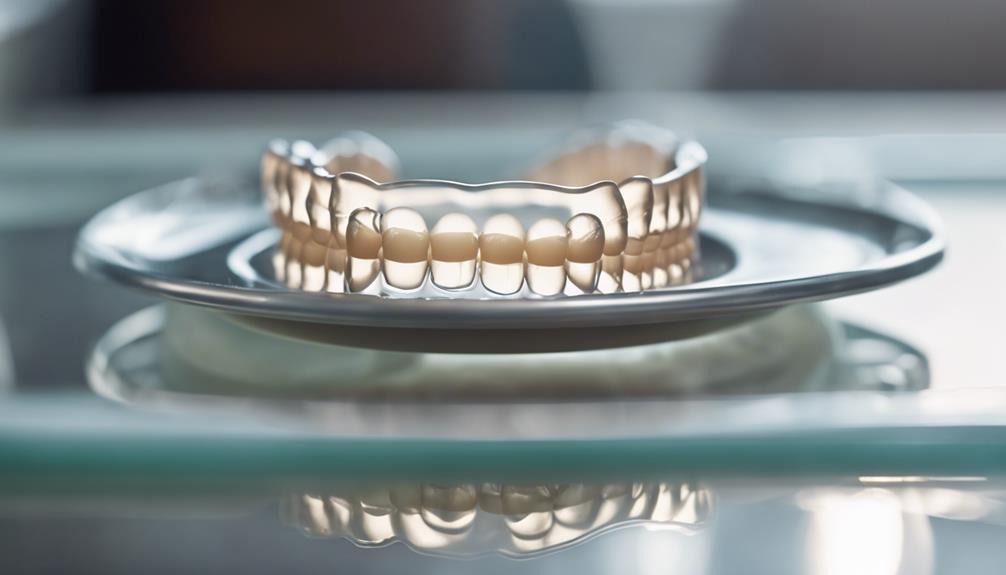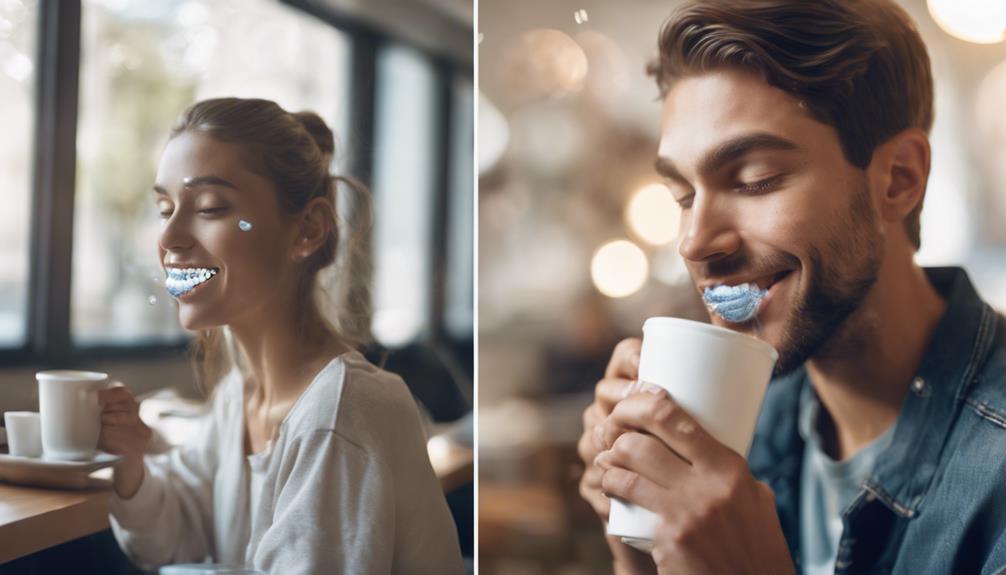While wearing Invisalign, it's important to understand the risks associated with drinking coffee, as the acidity, sugar, and heat can compromise your treatment progress and lead to unwanted consequences such as tooth decay, staining, and warping of your aligners. To minimize these risks, remove your trays before consuming coffee, brush your teeth afterward, and prioritize good oral hygiene practices. By taking these precautions, you can enjoy your coffee while protecting your teeth and ensuring the effectiveness of your Invisalign treatment. As you navigate the complexities of coffee consumption with Invisalign, you'll discover more ways to maintain a healthy, coffee-friendly smile. To help mitigate the potential risks of drinking coffee with Invisalign, consider using a straw to minimize contact between the coffee and your teeth. Additionally, try to limit the frequency of coffee consumption throughout the day to reduce the overall impact on your aligners and oral health. By being mindful of your coffee habits and following recommended guidelines, you can continue to enjoy your favorite beverage while maintaining the integrity of your Invisalign treatment. Remember, a little extra effort in managing drinking coffee with Invisalign can go a long way in preserving your smile and achieving successful results.
Key Takeaways
• Remove Invisalign trays before drinking coffee to prevent staining, warping, and decay.
• Brush teeth and rinse aligners after consuming coffee to maintain oral health and prevent staining.
• Drinking coffee with Invisalign trays in can lead to discoloration, warping, and decay, compromising treatment progress.
• Avoid hot coffee, as it can warp aligners, and opt for cold brew or teeth-friendly alternatives instead.
• Prioritize good oral hygiene practices, such as regular brushing and flossing, to ensure successful Invisalign treatment.
Risks of Coffee With Invisalign
When you drink coffee with Invisalign, you're exposing your teeth and aligners to a triple threat of acidity, sugar, and heat that can compromise your orthodontic treatment. The acidity in coffee increases the risk of tooth decay, which can hinder your treatment progress.
Additionally, the sugar content in coffee feeds the bacteria in your mouth, leading to further tooth decay. Additionally, the heat from hot coffee can cause your aligners to change shape, which may delay your treatment progress.
It's crucial to be aware of these risks to make certain you're not sabotaging your orthodontic treatment. Drinking coffee with Invisalign can also lead to staining of both your teeth and aligners, affecting the aesthetics of your treatment.
To minimize these risks, consider reducing your coffee consumption or taking precautions to protect your teeth and aligners. By understanding the risks associated with drinking coffee with Invisalign, you can take steps to ensure a successful treatment outcome.
Importance of Removing Trays

By removing your Invisalign trays before drinking coffee, you'll prevent the staining and warping of your aligners, ensuring a successful orthodontic treatment outcome. Drinking coffee while wearing your trays can lead to discoloration and damage to your aligners, which can negatively impact your Invisalign treatment.
Remove any sugar or cream from your coffee to minimize the risk of tooth decay, and rinse your mouth with water to remove any lingering sugars. When enjoying your coffee, store your trays safely in their case to prevent damage or loss.
Failing to remove your trays can lead to a buildup of coffee stains, which can discolor your aligners and teeth. By following these guidelines, you can enjoy your coffee while ensuring the success of your Invisalign treatment. Remember, removing your trays before drinking coffee is essential to maintaining a healthy, successful orthodontic treatment outcome.
Coffee Stains on Teeth and Aligners

As you continue to drink coffee with your Invisalign, you're likely to encounter an unwelcome side effect: stains on both your teeth and aligners. Coffee's dark side effects can lead to discoloration, affecting the appearance of your teeth and the discreetness of your treatment.
Coffee's Dark Side Effects
Drinking coffee regularly can lead to unsightly stains on both your teeth and Invisalign aligners, compromising their appearance. Coffee's dark side effects don't stop there. As you sip your morning coffee, you're introducing an acidic substance into your mouth that can increase the risk of tooth decay.
Hot beverages like coffee can also warp the shape of your Invisalign trays over time, leading to misshapen aligners that may require replacement. Stained aligners can become more visible, potentially impacting the effectiveness of your treatment. Additionally, misshapen aligners from exposure to hot coffee can lead to delays in your Invisalign progress. You may need to revisit previous stages of treatment or even restart the process, adding time and expense to your orthodontic journey.
It's crucial to weigh the benefits of your daily coffee habit against the potential risks to your teeth and aligners. By understanding coffee's dark side effects, you can make informed decisions that protect your teeth and ensure a successful Invisalign treatment.
Preventing Aligner Discoloration
You can guarantee coffee's discoloring effects on your teeth and Invisalign trays by adopting a few simple habits. Wearing Invisalign trays requires extra care to prevent discoloration and maintain their effectiveness in teeth straightening.
To confirm your trays remain clear and your smile stays bright, follow these essential tips:
- Consume coffee quickly within 15-30 minutes to reduce staining.
- Brush your teeth and rinse your aligners after drinking coffee to prevent bacterial growth and plaque buildup.
- Limit cream and sugar in your coffee to reduce the risk of bacterial growth.
- Avoid drinking hot coffee regularly, as the heat may warp your Invisalign trays over time, impacting their fit and effectiveness.
Warping of Invisalign Trays

Heat from hot beverages like coffee can quietly creep into your Invisalign trays, causing them to warp over time. This warping of Invisalign trays can have a significant impact on your treatment, as it affects the fit and effectiveness of your aligners.
When your trays are exposed to heat, they can become misshapen, which may prevent them from aligning your teeth properly. This can lead to potential setbacks in your Invisalign treatment.
To avoid warping your trays, it's important to keep hot beverages away from them. By doing so, you can maintain the integrity of your aligners and ensure they continue to function as intended. Remember, warped trays can compromise the success of your treatment, so it's vital to take precautions.
Good Oral Hygiene Practices

As you take steps to protect your Invisalign trays from heat damage, don't forget that good oral hygiene practices are also essential to the success of your treatment, especially when consuming coffee. By following good oral hygiene habits, you can guarantee a successful Invisalign treatment while still enjoying your daily cup of coffee.
Here are some essential practices to keep in mind:
- Brushing and flossing after coffee consumption helps prevent plaque buildup and maintain oral health.
- Rinsing your mouth with water after drinking coffee helps prevent plaque buildup and maintain oral health.
- Regularly cleaning your Invisalign trays after consuming coffee can prevent staining and discoloration.
- Removing your Invisalign trays before drinking coffee can help avoid potential damage to the aligners.
Safe Coffee Consumption Tips

To guarantee your Invisalign treatment stays on track, adopt these safe coffee consumption habits to minimize the risks of staining and damage. When you drink your coffee while wearing Invisalign, remember to rinse your mouth and aligners with lukewarm water afterwards to prevent staining. To further protect your Invisalign, consider switching to drinking coffee through a straw to minimize contact with your aligners. Additionally, consider investing in a costeffective coffee program that includes tooth-friendly options like low-acid, non-staining coffee alternatives. By following these safe coffee consumption habits, you can enjoy your daily cup of coffee without compromising the progress of your Invisalign treatment.
Limit coffee intake to maintain the aligners' appearance and prevent discoloration. Prioritize proper cleaning of your Invisalign trays after consuming coffee to prevent plaque buildup. Additionally, be mindful of the temperature of your coffee, as hot coffee can potentially warp the Invisalign trays over time.
Alternatives to Coffee and Tea

As you consider alternatives to coffee and tea, you may want to explore herbal tea options that are gentle on your Invisalign aligners.
You can also look into low-acid coffee choices that minimize the risk of staining or damaging your trays.
Herbal Tea Options
You can explore a variety of herbal teas, which offer a caffeine-free alternative to coffee and traditional tea, and discover flavors and benefits that suit your taste preferences. Herbal teas are an excellent choice for those looking to avoid caffeine or seeking a soothing, relaxing beverage.
Some popular herbal tea options include:
- Chamomile: Known for its calming effects and ability to promote relaxation
- Peppermint: Aids digestion and can help alleviate nausea
- Hibiscus: Rich in vitamins and minerals, and may help lower blood pressure
- Fruit-based blends: Offer an invigorating and fruity twist on traditional herbal teas
Enjoying herbal teas can be an invigorating and nourishing way to stay hydrated throughout the day. With a wide range of herbal tea blends available, there's something for every taste preference.
Low-Acid Coffee Choices
If you're craving a coffee-like experience without the acidity, explore low-acid coffee options that are gentler on your teeth and Invisalign trays. Cold brew or nitro coffee are great alternatives, offering a smoother flavor profile without the harsh acidity that can damage your teeth or Invisalign aligners.
If you're not in the mood for coffee at all, consider reaching for herbal teas like chamomile or peppermint instead. These caffeine-free options provide a soothing, teeth-friendly beverage experience.
Alternatively, you can opt for green tea, a low-acid option that won't cause staining or damage to your Invisalign trays. For a more exotic option, try golden milk, made with turmeric and milk, which is a soothing and teeth-friendly beverage to enjoy.
If you're looking for something even lighter, opt for water infused with fruits or herbs, providing an invigorating and aligner-safe alternative to coffee or tea. These options allow you to indulge in a flavorful drink while keeping your teeth and Invisalign aligners safe.
Avoiding Discoloration and Decay

Drinking coffee daily with your Invisalign trays in can lead to a perfect storm of discoloration and decay. As you sip on your morning coffee, the acidity and sugar in it can seep into the tiny crevices of your teeth, increasing the risk of tooth decay. Moreover, the heat from the hot beverage can cause your Invisalign trays to warp over time.
To avoid these issues, it's essential to take precautions:
- Remove your Invisalign clear aligners before consuming coffee to prevent staining and damage.
- Brush your teeth after coffee consumption to maintain good oral hygiene and prevent decay.
- Avoid drinking coffee with your Invisalign trays in, as it can lead to discoloration of both the aligners and your teeth.
- Prioritize good oral hygiene practices to counter the risks associated with drinking coffee with Invisalign.
Maintaining Invisalign Effectiveness

By committing to a consistent wear schedule, you'll be able to maintain the effectiveness of your Invisalign treatment while still enjoying your daily cup of coffee. To do this, guarantee you wear your aligners for at least 20-22 hours per day.
When you want to drink coffee, properly remove and store your Invisalign trays beforehand to prevent staining and warping. Try to drink your coffee quickly, within 15-30 minutes, to minimize the time without wearing your aligners.
After consuming coffee, brush your teeth and rinse your aligners to prevent plaque buildup and discoloration. By adjusting your lifestyle to accommodate coffee cravings while adhering to the recommended Invisalign wear time, you'll achieve best results.
Frequently Asked Questions
What Happens if You Drink Coffee With Invisalign?
When you drink coffee with Invisalign, you're risking damage to your aligners and teeth. The heat from hot coffee can warp your trays, while the tannins and acidity can stain both your aligners and teeth.
Moreover, sugary coffee increases the risk of tooth decay and plaque buildup. To avoid these issues, it's recommended that you remove your Invisalign trays before drinking coffee and practice proper oral hygiene afterwards to maintain good dental health.
Can You Drink Through a Straw While Wearing Invisalign?
As you navigate life with Invisalign, you might wonder: can you drink through a straw while wearing Invisalign?
The answer is yes, but with caution.
Did you know that 60% of orthodontic patients report damaging their aligners while eating or drinking?
To minimize risks, use a straw to reduce direct contact between your coffee and aligners.
Opt for reusable or paper straws to be eco-friendly.
Just be mindful of hot beverages, as they can warp your trays.
What Drinks Are OK With Invisalign?
When it comes to drinking with Invisalign, you're likely wondering what beverages are safe for your aligners. The answer is simple: water is the only recommended drink while wearing Invisalign.
This is because water won't stain, warp, or damage your aligners, unlike other beverages that can cause harm. Stick to water to maintain your oral health and the integrity of your aligners.
Why Can't I Drink Iced Coffee With Invisalign?
Understanding the risks associated with iced coffee and Invisalign is crucial. You might believe it's harmless, but cold beverages like iced coffee can still pose potential issues. The sugar and acidic content in iced coffee can contribute to plaque buildup and staining on your aligners.
To reduce negative effects, consider limiting your intake of iced coffee or taking precautions such as consuming it quickly and rinsing your trays afterwards.
Conclusion
You've invested time and money into perfecting your smile with Invisalign, so don't let a daily cup of joe ruin everything.
As you sip your coffee, imagine the dark liquid seeping into the tiny crevices of your aligners, leaving behind a permanent stain. It's a steep price to pay for a caffeine fix.
By removing your trays and practicing good oral hygiene, you can enjoy your coffee guilt-free, ensuring a healthy, radiant smile that's worth more than any coffee buzz.









